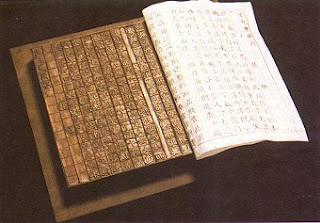Week Three | Robotics + Art
This week's videos and readings described how art was and is going to be influenced by industrialization. As printing press was introduced to the west, "the Age of Mechanical Reproduction" gradually started. Mass production became possible and knowledge exchange became easier. For instance, religious knowledge can be spread to larger amount of people. However, as Walter Benjamin, a German Jewish philosopher and cultural critic, demonstrated in his essay “The Work of Art in the Age of Mechanical Reproduction”, art's use for ritual functions decreases. Machines put an end to the idea of uniqueness or authenticity. The emerging of photography and films enriched art, but at the same time they pulled the value of art closer to politics. Art was no longer pure art.
When machines quickly took over some work from humans, they showed up more and more frequently in films and other art works, such as Charlie Chaplin's Modern Times and the classical science fiction movie Blade Runner. In the beginning, many of these art works illustrated machines as something evil and uncontrollable. However, machines started to be portrayed as friendly and helpful, like the aesthetics of robots in Japan. Robots are popular in manga and animation, showing human emotions and ethics. They often work with human beings and bring entertainment.
A classic image of robots in Japan is the Astro Boy (Atom). I was born and raised in China, but when I was small, I could see the image of Atom everywhere in the city. Atom was printed on T-shirts and cups, and shown on buildings. He looked cute and affable, flying with flame injector under his shoes. He never seemed sturdy, but he was always able to help others. Atom was favored by many young people at that time. The imaging of Atom showed people's positive imagination about robotics and human's future with machines.
Reference:
Astro Boy. Directed by Kazuya Konaka. Tezuka Productions, 2005.
Benjamin, Walter. "The Work of Art in the Age of Mechanical Reproduction." 1936.
Blade Runner. Directed by Ridley Scott, performances by Harrison Ford, Rutger Hauer, Sean Young, and Edward James Olmos, Shaw Brothers, 1982.
Davis, Douglas. "The Work of Art in the Age of Digital Reproduction (An Evolving Thesis: 1991-1995)." Leonardo 28.5 (1995): 381-86. JSTOR [JSTOR]. Web. 22 Apr. 2017.
UC Online Program. "Robotics MachikoKusahara 1.” Online video clip. YouTube. YouTube, 14 April 2012. Web. 21 April 2017.
 |
| Printing Press in China (csmh) |
When machines quickly took over some work from humans, they showed up more and more frequently in films and other art works, such as Charlie Chaplin's Modern Times and the classical science fiction movie Blade Runner. In the beginning, many of these art works illustrated machines as something evil and uncontrollable. However, machines started to be portrayed as friendly and helpful, like the aesthetics of robots in Japan. Robots are popular in manga and animation, showing human emotions and ethics. They often work with human beings and bring entertainment.
 |
| Charlie Chaplin - Modern Times (Pinterest) |
A classic image of robots in Japan is the Astro Boy (Atom). I was born and raised in China, but when I was small, I could see the image of Atom everywhere in the city. Atom was printed on T-shirts and cups, and shown on buildings. He looked cute and affable, flying with flame injector under his shoes. He never seemed sturdy, but he was always able to help others. Atom was favored by many young people at that time. The imaging of Atom showed people's positive imagination about robotics and human's future with machines.
 |
| Atom (Pinterest) |
 |
| Robot Atom (Pinterest) |
Reference:
Astro Boy. Directed by Kazuya Konaka. Tezuka Productions, 2005.
Benjamin, Walter. "The Work of Art in the Age of Mechanical Reproduction." 1936.
Blade Runner. Directed by Ridley Scott, performances by Harrison Ford, Rutger Hauer, Sean Young, and Edward James Olmos, Shaw Brothers, 1982.
Davis, Douglas. "The Work of Art in the Age of Digital Reproduction (An Evolving Thesis: 1991-1995)." Leonardo 28.5 (1995): 381-86. JSTOR [JSTOR]. Web. 22 Apr. 2017.
UC Online Program. "Robotics MachikoKusahara 1.” Online video clip. YouTube. YouTube, 14 April 2012. Web. 21 April 2017.

Comments
Post a Comment